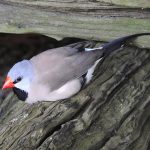LONG-TAILED FINCH
Long-tailed finches are primarily found in northern and eastern parts of Australia, particularly in the savannah woodlands, grasslands, and open forests. They prefer areas with tall grasses and shrubs, as these provide shelter and food sources.
These finches are quite distinctive with their striking plumage. They have bright red faces and throats, contrasting with their brownish-grEy bodies. Their most notable feature is their long, black-tipped tail feathers, which give them their common name.
Long-tailed finches are highly social birds and are often seen in flocks. These flocks can consist of dozens to even hundreds of individuals. Their social structure is complex, with dominant pairs within the flock that have priority access to resources.
These finches primarily feed on seeds, especially grass seeds. They are known to forage on the ground or in grassy vegetation, using their strong beaks to crack open seeds. They may also eat insects on occasion.
Long-tailed finches are cavity-nesting birds, and they often choose tree hollows or artificial nest boxes for breeding. They typically breed during the wet season when food is more abundant. The female lays a clutch of eggs, and both parents take turns incubating them and feeding the chicks.
These finches are known for constructing some of the most intricate nests in the bird world. Their nests can be a combination of twigs, grass, and feathers, and they are often elaborately decorated with flowers and other colorful materials.
Long-tailed finches are quite vocal, and their melodious calls are a common sound in their habitat. They use various calls to communicate with one another, especially during courtship and within their social groups.
Long-tailed finches face several threats in the wild, including habitat loss due to agriculture and land development. They are also vulnerable to predation by introduced species such as feral cats and foxes.
Long-tailed finches play an important role in their ecosystem by helping to disperse seeds of various plant species. They also serve as prey for a variety of native and introduced predators, contributing to the broader food web.







